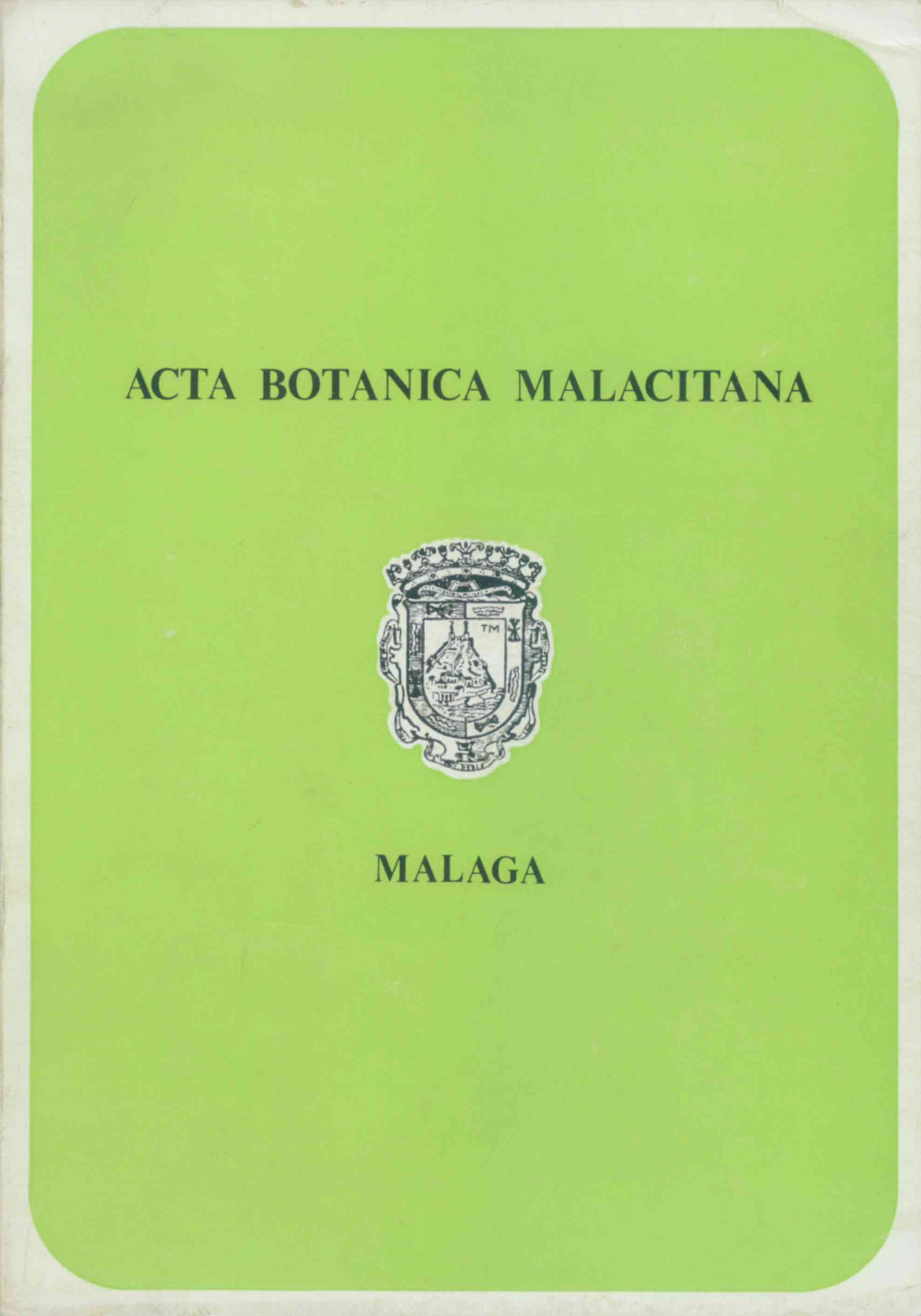Notas cariosistemáticas sobre flora española, I
DOI :
https://doi.org/10.24310/Actabotanicaabmabm.v2i.9704Mots-clés :
.Résumé
Se ha estudiado el número cromosómico de 21 táxones ibéricos. Creemos nuevos para la ciencia los recuentos siguientes: Gypsophila struthium Loefl. (2n=34); Lepidium subulatum L. (2n=16); lberis cinerea Poiret (2n=44); Erucastrum nasturtiifolium (Poiret) O. E. Schulz var. subbipinnatifidum (Lag.) Thell. (2n=16); Teucrium gnaphalodes L'Hér. subsp. jaenense (Lacaita) Rivas-Martínez (2n=26); Teucrium pumilum L. (2n=26); Centazirea alpina L. (2n=30); Centaurea hyssopifolia Vahl (2n=22); Launaea resedifolia (L.) O. Kuntzee (2n=18).
Se reivindica el rango específico para lberis cinerea Poiret y se insiste sobre la identidad de Centaurea linaresii Láz. Ibiza y C. alpina L
Téléchargements
Métriques
Références
BELLOT, F. & RON, M. E. (1975). Notas sobre algunas Centaureas de España. Trabajos del Departamento de Botánica, Madrid, 7, 3-9.
COUTINHO, L. DE A. & LORENZO-ANDREU, A. (1948). Contribución al estudio cariológico de la flora espontánea de la estepa de Aragón, I. Anales de la Estación Experimental Aula Dei, 1, 3-13.
DAHLGREN, R., KARLSSON, TH. & LARSEN, P. (1971). Studies on the flora of the Balearic Islands, I. Botaniska Notiser, 124, 249-269.
DOSTÁL, J. (1976). Centaurea L. In: T. G. Tutin & al. (Eds.), Flora Europaea (Vol. 4, pp. 254-301). Cambridge University Press.
FAVARGER, Cl. & CONTANDRIOPOULOS, J. (1961). Essai sur l'endémisme. Bulletin de la Société Botanique Suisse, 71, 384-407.
FERNANDES, A. (1937). Le problème de Narcissus tazetta L., I. Les formes à 22 chromosomes somatiques. Boletim da Sociedade Broteriana, 12, 159-219.
FERNANDES, A. (1950). Sur la caryologie de Lapiedra martinezii Lag. Boletim da Sociedade Broteriana, 24, 281-319.
FERNANDES, A. (1967-1968). Contribution à la connaissance de la biosystématique de quelques espèces du genre Narcissus L. Portugaliae Acta Biologica (Sér. B), 9, 1-44.
FERNANDES, A. & QUEIRÓS, M. (1971). Sur la caryologie de quelques plantes récoltées pendant la III Réunion de Botanique Péninsulaire. Memórias da Sociedade Broteriana, 21, 343-379.
FERNANDES, A. & QUEIRÓS, M. (1971). Contribution à la connaissance cytotaxinomique des Spermatophyta du Portugal, II. Compositae. Boletim da Sociedade Broteriana, 45, 5-121.
GADELLA, T. W. J., KLIPHUIS, E. & MENNEGA, E. A. (1966). Chromosome numbers of some flowering plants of Spain and S. France. Acta Botanica Neerlandica, 15, 484-489.
GUINOCHET, M. & LEFRANC, M. (1972). IOPB chromosome number reports XXXVII. Taxon, 21, 495-500.
HEYWOOD, D. J. (1972). A contribution to the cytotaxonomy of Brassica (Cruciferae) and its allies. Botanical Journal of the Linnean Society, 65, 1-23.
JANSEN, H. W. (1936). Meiosis in Rumex. I. Polyploidy and the origin of new species. Cytologia, 7, 1-22.
KIHARA, H. & ONO, T. (1926). Chromosomenzahlen und systematische Gruppierung der Rumex-Arten. Zeitschrift für Zellforschung und mikroskopische Anatomie, 4, 475-481.
KAWATANI, T. & OHNO, T. (1964). Chromosome numbers in Artemisia. Bulletin of the National Institute of Hygienic Sciences, 82, 183-193.
LORENZO-ANDREU, A. & GARCÍA SANZ, P. (1950). Cromosomas somáticos de plantas espontáneas en la estepa de Aragón, II. Anales de la Estación Experimental Aula Dei, 2, 12-20.
LÖVE, A. (1942). Cytogenetic studies in Rumex, III. Some notes on Scandinavian species of the genus. Hereditas, 28, 289-296.
LÖVE, A. & KJELLQVIST, E. (1974). Cytotaxonomy of Spanish plants, III. Dicotyledons: Salicaceae-Rosaceae. Lagascalia, 4, 3-32.
MALECI, L. B. & MORI, B. (1972). Numeri cromosomici per la flora italiana. Informatore Botanico Italiano, 4, 224-236.
MANTOS, I. (1932). Introduction to the general cytology of the Cruciferae. Annals of Botany, London, 46, 509-556.
MURÍN, A. & CHAUDHRI, I. I. (1970). IOPB Chromosome number reports, XXVI. Taxon, 19, 264-269.
PUECH, S. (1970). IOPB Chromosome number reports XXVII. Taxon, 19, 437-442.
PUECH, S. (1972). IOPB Chromosome number reports, XXXVII. Taxon, 21, 495-500.
PUECH, S. (1974). IOPB Chromosome number reports, XLVI. Taxon, 23, 810.
PUECH, S. (1975). Contribution caryologique à l'étude des Teucrium de la Section Polium du bassin méditerranéen occidental. Colloques Internationaux du CNRS, n.º 225: La flore du bassin méditerranéen, 223-238.
RIVAS-MARTÍNEZ, S. (1974). Avance sobre una síntesis corológica de la península ibérica, Baleares y Canarias. Anales del Instituto Botánico Cavanilles, 30, 69-87.
RIVAS-MARTÍNEZ, S. (1974). Sobre Teucrium pumilum L. (Lamiaceae) y sus especies afines. Anales del Instituto Botánico Cavanilles, 31, 79-96.
RIVAS-MARTÍNEZ, S. (1976). De plantis Hispaniae notulae systematicae, chorologicae et ecologicae, I. Candollea, 31, 111-116.
RUIZ REJÓN, M. (1974). IOPB Chromosome number reports, XLVI. Taxon, 23, 805-806.
REESE, G. (1957). Über die Polyploidiemuster in der nordafrikanischen Wüstenflora. Flora, 144, 598-634.
VALDÉS, B. (1970). Números cromosómicos de algunas plantas españolas. Boletín de la Real Sociedad Española de Historia Natural (Biología), 68, 193-197.
VALDÉS-BERMEJO, E. (1970). Estudios cariológicos en crucíferas españolas de los géneros Moricandia DC., Vella L., Carrichtera Adans. y Hutera Porta. Anales del Instituto Botánico Cavanilles, 27, 125-133.
WEITZ, S. & FEINBRUN, N. (1972). Cytology and systematics of Narcissus tazetta L. in Israel. Israel Journal of Botany, 21, 9-20.
Téléchargements
Publiée
Comment citer
Numéro
Rubrique
Licence
(c) Tous droits réservés Acta Botanica Malacitana 2020

Ce travail est disponible sous licence Creative Commons Attribution - Pas d’Utilisation Commerciale - Partage dans les Mêmes Conditions 4.0 International.
Les auteurs publiant dans cette revue acceptent les termes suivants :
- Rétention des droits
Les auteurs conserveront leurs droits d’auteur et accorderont à la revue un droit de distribution non exclusif pour la première publication de leur œuvre. - Licence d’utilisation
Les articles sont publiés sous la licence Creative Commons Attribution 4.0 (CC BY 4.0). Cette licence permet à toute personne de partager et d’adapter l’œuvre, à condition de reconnaître l’auteur et d’inclure un lien vers la licence. - Droits de réutilisation des auteurs
Les auteurs peuvent réutiliser, distribuer et archiver la version publiée de leur article sans restriction. Le dépôt dans des archives institutionnelles, des réseaux sociaux académiques, des blogs personnels et d’autres plateformes est encouragé, car il favorise sa visibilité et sa citation au sein de la communauté académique. - Promotion de la diffusion
Les auteurs sont autorisés et encouragés à partager leur travail sur des plateformes en ligne avant et pendant le processus de soumission. Cette pratique peut favoriser les échanges académiques et accroître la diffusion et l’impact de l’œuvre publiée.








1.png)
